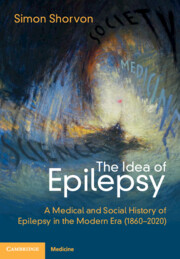Book contents
- The Idea of Epilepsy
- The Idea of Epilepsy
- Copyright page
- Dedication
- Contents
- Preface
- Section 1 The Voyage Of The Good Ship Epilepsy
- Section 2 ‘A Plague upon Your Epileptic Visage’
- One 1860–1914: The Birth of Modern Epilepsy
- Two 1914–1945: Epilepsy in the Age of Catastrophe
- Three 1945–1970: Epilepsy and the New World Order
- Four 1970–1995: Epilepsy in a Globalised World
- Five 1995–2020: The Epilepsy Floods are Too Recent
- Section 3 Epilepsy: The Paradigm of the Suffering of Both Body and Soul in Disease
- Book part
- Glossary
- Bibliography
- Index of Names
- Index
Two - 1914–1945: Epilepsy in the Age of Catastrophe
from Section 2 - ‘A Plague upon Your Epileptic Visage’
Published online by Cambridge University Press: 13 January 2023
- The Idea of Epilepsy
- The Idea of Epilepsy
- Copyright page
- Dedication
- Contents
- Preface
- Section 1 The Voyage Of The Good Ship Epilepsy
- Section 2 ‘A Plague upon Your Epileptic Visage’
- One 1860–1914: The Birth of Modern Epilepsy
- Two 1914–1945: Epilepsy in the Age of Catastrophe
- Three 1945–1970: Epilepsy and the New World Order
- Four 1970–1995: Epilepsy in a Globalised World
- Five 1995–2020: The Epilepsy Floods are Too Recent
- Section 3 Epilepsy: The Paradigm of the Suffering of Both Body and Soul in Disease
- Book part
- Glossary
- Bibliography
- Index of Names
- Index
Summary
At the beginning of this period, psychiatry and psychology still dominated the management of epilepsy. Psychometry was widely used in epilepsy colonies, laws were passed restricting the rights of those with mental handicap, and psychoanalytical theories of seizures, conceived as symptoms of infantile regression, and also of the epileptic personality were widely held. Diverse theories of heritability were postulated. The rise of eugenics, as well as of psychoanalytical theories, greatly worsened the stigma of epilepsy. Eugenic measures were introduced which included involuntary sterilisation in some countries, and ‘mercy killings’ by the Nazi regime. In the later years, the science of epilepsy advanced with studies of neurochemistry, neuropathology and neurophysiology, and in the late 1930s EEG burst into the clinical arena. Treatment also made progress with the introduction of the ketogenic diet and then Phenytoin. The two world wars resulted in new interest in the surgical treatment of post-traumatic seizures. Attitudes to epilepsy remained largely hostile and the condition featured in the works of well-known authors including Thomas Mann, Agatha Christie, Joseph Roth and John Cowper Powis, who had epilepsy but never revealed this publicly. The ILAE ceased to function in 1914 but was resuscitated in 1937.
Keywords
- Type
- Chapter
- Information
- The Idea of EpilepsyA Medical and Social History of Epilepsy in the Modern Era (1860–2020), pp. 148 - 261Publisher: Cambridge University PressPrint publication year: 2023

